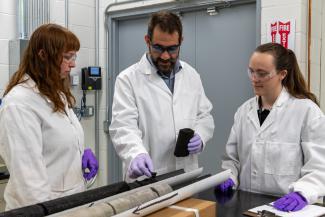The United States currently imports nearly all its supply of rare earth elements (REEs), which are a group of critical minerals that are vital for decarbonizing the energy system. However, NETL researchers have been on the hunt to discover a multitude of resources and to understand the nature and recoverability of these valuable materials within our own borders, opening a pathway to reestablishing the nation as a global leader in REE production.
“The need for critical minerals such as REEs continues to grow every year,” NETL’s Burt Thomas said. “An estimate by the International Energy Agency shows demand at least quadrupling by 2040. In addition to everyday technologies like cellphones, computers and electric vehicles, REEs are essential for building clean energy technologies. Wind turbines, for example, need strong magnets built with some of the rarest REEs. As the nation continues to transition to a clean energy future, REE demand will also continue to rise.”
America’s import dependency creates vulnerabilities in the REE supply chain due to physical scarcity, trade policy, mining and refinement constraints, geopolitical conflicts and other issues. Such disruption could impede or halt the development of clean energy technologies that are critical for battling climate change and ensuring a prosperous energy future. Furthermore, because REEs are used in technologies for national defense, establishing a domestic supply chain is a strategic necessity on multiple fronts.
“NETL has developed considerable expertise when it comes to examining unconventional domestic sources of critical minerals,” Thomas said. “For instance, there are regions of the country containing coal-related sediments that we have characterized and found to contain significant quantities of REEs, including heavy REEs, which are the hardest to find.”
These same regions also feature supplies of coal, coal byproducts and coal waste that can be converted into high-value products, rather than simply burned as fuel. In fact, coal-related materials are an important source of carbon that can be used for manufacturing a range of products such as carbon fiber for golf clubs, tennis rackets, and wind turbine blades — research NETL actively supports.
“Because you can find and extract REEs in coal-related resources that can also be used as feedstocks to create other products, domestic coal and coal waste could become a source for both the materials we need to build the turbine blades as well as the strong magnets necessary to turn wind into electricity,” Thomas said.
As a government-owned and operated national lab, NETL is committed to playing a critical role in the development of these unconventional resources and providing our capabilities, knowledge and data to the public, including industries interested in exploring unconventional resources in their region.
The lab has already built strong partnerships with industries that are making considerable advances in this field and continues to develop and fund science and technology to find, characterize and recover these valuable resources from unconventional feedstocks.
“For example, this year NETL developed and publicly released the Unconventional Rare Earth and Critical Materials Assessment Method, a big-data approach to prospect for critical minerals resources associated with sediments. Since 2018, NETL has worked with Ramaco Carbon inside a cooperative research and development agreement to understand the distribution and geochemical data that could inform, improve and validate the method,” Thomas said.
“NETL continues to develop the scientific basis that might explain the origin and nature of these valuable coal-related sedimentary resources so that we can understand how these resources can contribute to the critical mineral needs of the country. Since many of the most valuable minerals appear to be associated with non-carbon waste materials in coal-related sediments, deposits like Ramaco’s may provide the critical minerals we need to develop a reliable source of domestic critical minerals and materials even without the continued production of coal.”
The science development required to understand these resources also involves helping the community use the tools they have available to them. Recently, NETL published a study using material from the recently announced discovery at Brook Mine to prove out techniques to accurately analyze and assess coal-related core materials.
NETL is a U.S. Department of Energy national laboratory that drives innovation and delivers technological solutions for an environmentally sustainable and prosperous energy future. By leveraging its world-class talent and research facilities, NETL is ensuring affordable, abundant and reliable energy that drives a robust economy and national security, while developing technologies to manage carbon across the full life cycle, enabling environmental sustainability for all Americans.




